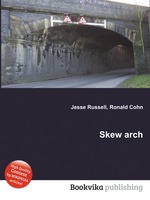Skew arch
Jesse Russell Ronald Cohn
бумажная книга
High Quality Content by WIKIPEDIA articles! A skew arch (also known as an oblique arch) is a method of construction that enables an arch bridge to span an obstacle at some angle other than a right angle. This results in the faces of the arch not being perpendicular to its abutments and its plan view being a parallelogram, rather than the rectangle that is the plan view of a regular, or "square" arch. In the case of a masonry skew arch the construction requires precise stonecutting as none of the cuts form right angles but once the principles were fully understood in the early 19th century it became considerably easier and cheaper to build a skew arch of brick. The problem of building skew arch masonry bridges was addressed by a number of early civil engineers and mathematicians, including William Chapman (1787), Benjamin Outram (1798), Peter Nicholson (1828), George Stephenson (1830), Edward Sang (1835), Charles Fox (1836), George W. Buck (1839) and William Froude (c. 1844).


